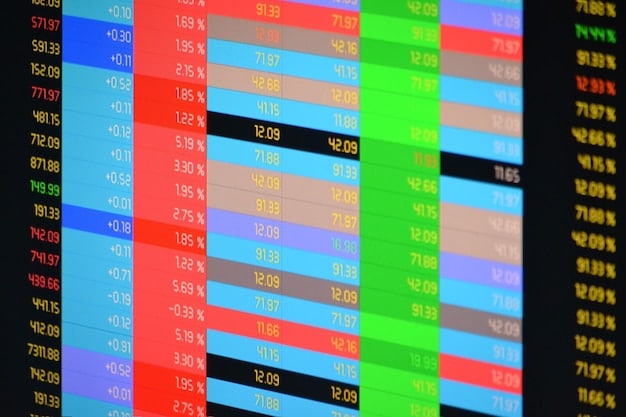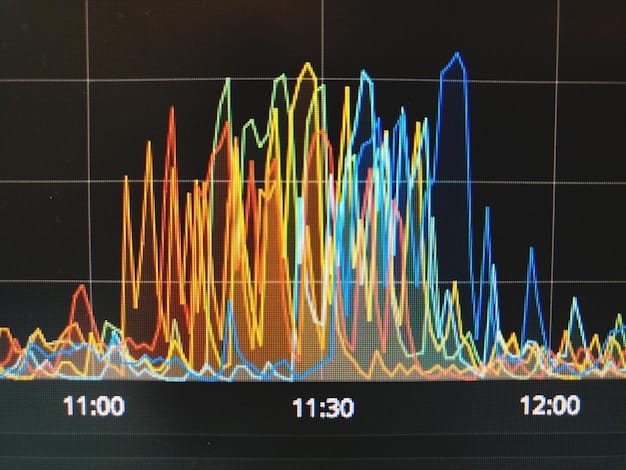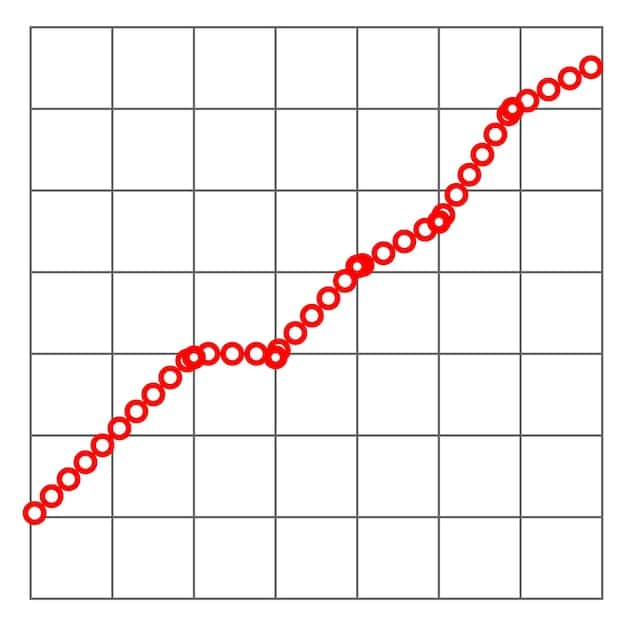Decoding Options Greeks: A Comprehensive Guide for Profit and Risk Management

Decoding Options Greeks: A Practical Guide to Managing Risk and Maximizing Profits offers traders essential insights into Delta, Gamma, Theta, Vega, and Rho, crucial tools for measuring option sensitivities and effectively managing risk exposure in the stock market.
Unlock the secrets of options trading with a clear understanding of the Greeks. Decoding Options Greeks: A Practical Guide to Managing Risk and Maximizing Profits provides you with the knowledge to navigate the complexities of option pricing and make informed decisions.
Understanding Options Greeks: An Introduction
Options Greeks are essential tools that help traders gauge the sensitivity of an option’s price to various factors. These factors include changes in the underlying asset’s price, time decay, volatility, and interest rates. Learning about options Greeks can empower you to manage risk and maximize profits in the options market.
Understanding these Greeks is vital for any options trader seeking to make informed decisions. They offer insights into how different factors can impact the value of an option, helping you manage risk more effectively.
What are Options Greeks?
Options Greeks are a series of measures that quantify different dimensions of risk associated with options trading. They help you understand potential changes in an option’s price due to various factors.
- Delta: Measures the change in an option’s price for a $1 change in the underlying asset’s price.
- Gamma: Measures the rate of change of Delta for a $1 change in the underlying asset’s price.
- Theta: Measures the rate of decline in the value of an option due to the passage of time.
- Vega: Measures the change in an option’s price for a 1% change in implied volatility.
- Rho: Measures the change in an option’s price for a 1% change in the risk-free interest rate.
In conclusion, understanding options Greeks means understanding the factors that influence an option price. Paying attention to these measures is essential for making astute trades because it helps traders to protect their positions and capitalize on market movements. These calculations are a tool every options trader needs.
Delta: Gauging Price Sensitivity
Delta is the first Greek we’ll explore, providing a critical measure of how an option’s price changes in relation to changes in the underlying asset’s price. This helps traders estimate the potential profit or loss associated with their options positions.
Delta is a crucial tool for understanding how sensitive an option is to movements in the underlying asset. It provides valuable insight into how much an option’s price is likely to move for every dollar change in the asset.
Delta Explained
Delta ranges from 0 to 1 for call options and 0 to -1 for put options. A call option with a delta of 0.6 will generally increase by $0.60 for every $1 increase in the underlying asset’s price. Conversely, a put option with a delta of -0.6 will decrease by $0.60 for every $1 increase in the underlying asset’s price. It’s a direct correlation between the option and its underlying asset.
Using Delta in Trading Strategies
Delta can be used to construct delta-neutral strategies. By combining options and the underlying asset in appropriate proportions, you can create a portfolio that is initially insensitive to small price movements in the underlying asset. This is extremely helpful when trying to hedge positions and protect profits.

In summary, delta is a pivotal Greek for assessing and managing an option’s price sensitivity. By closely monitoring delta, traders can adjust their strategies to profit from anticipated market movements while minimizing potential losses.
Gamma: Measuring Delta’s Rate of Change
Gamma represents the rate of change of Delta. Understanding gamma can help traders anticipate how much their delta will change as the underlying asset’s price moves, giving them a better understanding of their position’s risk.
Gamma provides valuable information about how quickly an option’s delta will change in response to price movements in the underlying asset. This can be particularly useful when managing short-term trades, helping to adjust strategies according to changing market conditions.
Understanding Gamma’s Impact
Gamma is highest for options that are at-the-money (ATM) and decreases as options move further in-the-money (ITM) or out-of-the-money (OTM). High gamma values indicate that an option’s delta is highly sensitive to small changes in the underlying asset’s price.
Gamma in Practical Scenarios
Traders can use gamma to manage the risk associated with their delta-hedged positions. By monitoring gamma, traders can anticipate when they need to rebalance their hedges to maintain a delta-neutral portfolio. This makes gamma essential to effectively managing risk and maximizing profits.
- Higher gamma indicates Δ changes more rapidly.
- ATM options have the highest gamma value.
- Gamma is always a positive number.
In summary, gamma is pivotal for understanding how an option’s delta can change and how that might impact an options position. Paying attention to gamma means traders can make smart decisions, change tactics as needed, and navigate the options market with greater insight.
Theta: Assessing Time Decay
Theta measures the rate at which an option’s value decreases over time. This metric is crucial for understanding how the passage of time erodes the value of options, particularly as they approach their expiration date.
Theta is a critical factor in options trading, especially for option sellers. Understanding how rapidly time decay affects an option’s value enables traders to optimize their strategies, ensuring they account for the diminishing value of options nearing expiration.
How Theta Affects Option Value
Theta is expressed as a negative number, signifying that each day that passes results in a loss of value for the option. The closer an option is to its expiration date, the higher its theta value, meaning the rate of time decay accelerates as expiration approaches. If an option expires worthless, knowing the theta can help a trader determine whether to sell or hold onto the option.
Theta in Trading Strategies
Theta is especially important for strategies like selling options or calendar spreads, where the goal is to profit from time decay. Traders using these strategies aim to maximize potential gains by selecting options with favorable theta values. For example, selling options with high theta values can generate income, provided the price of the underlying asset remains stable.

In conclusion, theta is a critical measure for assessing the impact of time decay on an option. By understanding theta, traders can make informed decisions on how to manage their positions to profit from time decay or mitigate its effects.
Vega: Gauging Sensitivity to Volatility
Vega measures the sensitivity of an option’s price to changes in implied volatility. Since implied volatility is forward-looking and reflects the market’s expectation of future price swings, Vega is an important tool for managing risk.
Vega offers insights into how sensitive an option’s price is to swings in implied volatility. By closely tracking vega, traders can estimate how changing volatility might affect their profitability with different strategies.
How Vega Impacts Option Value
Vega is always a positive value for both call and put options, indicating that an increase in implied volatility will generally increase the option’s price, and a decrease in volatility will decrease its price. Options that are at-the-money (ATM) typically have the highest Vega values because their prices are most sensitive to changes in volatility.
Applying Vega in Trading Scenarios
Vega is particularly useful when trading options based on anticipated changes in market volatility. For example, traders who expect volatility to increase may buy options to benefit from the rise in option prices. Conversely, traders who anticipate a decrease in volatility may sell options, aiming to profit from the decline in option prices.
- A higher Vega means the option is more sensitive to volatility changes.
- ATM options generally have the highest Vega values.
- Vega is positive for both calls and puts.
In summary, Vega is an important Greek number, revealing how fluctuations in implied volatility can raise or lower an option’s value. By factoring in vega, traders can modify their positions based on predictions about how market volatility will change to potentially minimize losses or optimize profits.
Rho: Assessing Interest Rate Sensitivity
Rho measures the sensitivity of an option’s price to changes in interest rates. Interest rates typically have a more modest impact on shorter-term options than other factors, but Rho remains valuable, especially when trading options over longer time horizons.
Rho is used to measure how sensitive the price of an option is to changes in interest rates. Therefore, it’s more valuable when trading options over longer time horizons.
Understanding Rho’s impact
Rho measures the change in an option’s price for each 1% change in the risk-free interest rate. Call options generally have a positive Rho, meaning their value increases as interest rates rise, while put options have a negative Rho, meaning their value decreases as interest rates rise.
Using Rho in Complex Strategies
While not as widely used as other Greeks, Rho can be important in strategies involving long-term options or options on interest-rate-sensitive assets. Additionally, Rho helps traders fine-tune the pricing models used to evaluate options, especially in markets where interest rate changes may be anticipated.
In conclusion, although its influence is usually less pronounced compared to other Greeks, Rho plays a crucial role in thoroughly assessing risks and hedging methods. By factoring in Rho, options traders can account for the less prominent but real impact of interest rate changes, leading to more precise and informed strategies.
Combining Greeks for Comprehensive Risk Management
Effectively managing risk in options trading requires more than just understanding individual Greeks. It involves combining them to build a comprehensive view of potential exposures and optimizing trading strategies for different market conditions.
To successfully manage risk in options trading, traders need an understanding of each option Greek and the skill to use them well. Employing this technique creates a big-picture perspective of possible vulnerabilities and enables the adjustment of trading strategies to suit varied market conditions.
Creating a Holistic Strategy
Each Greek provides a specific piece of information, and when used together, they offer a more complete picture of the risks and opportunities associated with an option. For example, understanding both Delta and Gamma allows traders to estimate not only how much an option’s price will change with a $1 move in the underlying asset but also how quickly that sensitivity might change.
Real-World Applications
Consider a trader implementing a delta-neutral strategy. While Delta helps in creating the initial hedge, Gamma alerts the trader to when the hedge needs to be rebalanced. Similarly, Vega helps in assessing how changes in market volatility could impact the overall position, and Theta highlights the effects of time decay on the options. Together, these Greeks provide a toolkit for dynamic risk management.
| Key Metric | Brief Description |
|---|---|
| 📈 Delta | Measures option price sensitivity to underlying asset price changes. |
| ⚡ Gamma | Indicates the rate of change of Delta, reflecting price volatility. |
| ⏰ Theta | Reflects the time decay of an option as it approaches expiration. |
| 🤔 Vega | Shows option sensitivity to changes in implied volatility. |
What is Delta?
▼
Delta measures how much an option’s price is expected to move for every $1 change in the price of the underlying asset. It ranges from 0 to 1 for call options.
▼
Gamma measures the rate of change of an option’s delta with respect to a $1 change in the price of the underlying asset. It indicates how unstable the delta of an option is.
▼
Theta indicates the rate at which an option’s value decreases over time. Also known as time decay, theta is greatest as an option nears its expiration date.
▼
Vega measures an option’s sensitivity to changes in implied volatility. Options generally increase in value when volatility rises and decrease when it falls.
▼
Rho measures an option’s sensitivity to changes in interest rates. Call options increase in value when rates rise, while the value of put options decline in the same situation.
Conclusion
In summary, mastering options Greeks is essential for making informed trading choices to maximize profits and manage risk. Understanding the nature and interaction of delta, gamma, theta, vega, and rho enables traders to evaluate potential losses and capitalize on different market circumstances. Combining strategies with options Greeks makes for smarter navigation and more chances for success in the options market.





